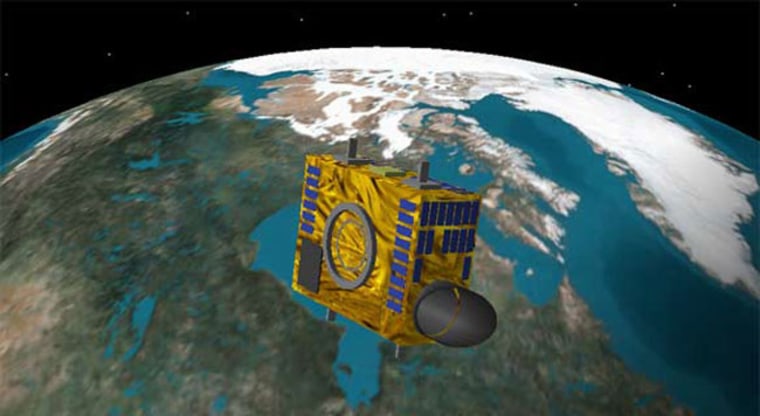A tiny Canadian satellite is gearing up for a mission to hunt wayward space rocks that may pose a threat to Earth.
Only the size of a suitcase, the Near Earth Object Surveillance Satellite (NEOSSat) has a 5.9-inch (15-cm) telescope and weighs about 143 pounds (65 kg). But it’s designed to hunt for threatening space rocks from Earth orbit, where the telescope can avoid interference from the planet’s atmosphere.
“That’s why a small telescope in space can be a lot more comparable to a large telescope on the ground,” said Alan Hildebrand, planetary scientist at the University of Calgary and head of the asteroid search project for NEOSSat.
The Canadian microsatellite would also keep an eye on Earth’s satellite traffic for both U.S. and Canadian space commands, swiveling around to target space rocks and satellites hundreds of times a day. That requires a revolutionary turning system for the $12 million-satellite to do its job upon launch in early 2010.
Astronomers have particular interest in Near Earth Objects, because such objects might threaten Earth in the near or distant future. Nearby asteroids could likewise serve as targets for future spacecraft missions to investigate.
NEOSSat will also shed more light on the less famous Inner Earth Objects, or asteroids found close to the sun within Earth’s orbit, mission managers said.
Point and click
NEOSSat draws upon the technological heritage of a star-gazing mission called MOST (Microvariability and Oscillation of STars), which represented Canada’s first space telescope. But the newer microsatellite also boasts an attitude control system based on spinning reaction wheels that allow it to turn quickly without consuming rocket fuel.
Slideshow 12 photos
Month in Space: January 2014
“We have to be able to point precisely at a chunk of sky for 100 seconds,” Hildebrand told SPACE.com. “Then you want to be able to slew from one field to another as fast as possible.”
Such rapid response balances out with the need to keep the space telescope steady on its target, whether peering at rocks in the asteroid belt or tracking a moving satellite.
“The attitude-control system is an absolute must,” said Brad Wallace, scientist at Defense Research Development Canada (DRDC), the agency working with the Canadian Space Agency on NEOSSat.
However, the system’s reaction wheels don’t require consumable fuel to do their work. NEOSSat will draw power from solar panels that convert the sun’s energy into the required amount of electricity — just 45 watts, or less power than an average light bulb.
Let’s go asteroid hunting
Low energy usage and a small size may make NEOSSat seem paltry compared to large ground telescopes that can cost $50 million and up. But scientists look forward to having a space telescope that can check out asteroids without bad weather or atmospheric background getting in the way.
“In terms of advantages of being in space, we’ve got 24/7 availability,” Hildebrand said.
Ground telescopes face limits even with blue skies on Earth, because the atmosphere makes it harder to spot the faint light signals from asteroids. NEOSSat reduces the background interference to one tenth of that on Earth, by going up roughly 435 miles (700 km) above the atmosphere.
Hildebrand hopes the microsatellite to discover at least 100 Near Earth Objects per year once operational, and many more asteroids in the main asteroid belt between Mars and Jupiter.
Space traffic control
The microsatellite will also spend half its time tracking other satellites in orbit around Earth.
“Our first and foremost goal is to demonstrate satellite tracking capability,” said Wallace, who leads the DRDC science team focused on traffic control.
Wallace’s team will spend NEOSSat’s first year testing new observing and tracking techniques, before handing over the keys to DRDC’s client, the Canadian Forces. That would allow the space telescope to take a more active role in helping the North American Aerospace Defense Command (NORAD) monitor the skies.
Satellite tracking requires slightly less of the microsatellite’s capabilities, but Wallace also plans to test it on scenarios such as tracking “lost” objects and doing hand-off coverage that picks up from where another telescope began.
NEOSSat’s ability to take on dual responsibilities points to a future where microsatellites increasingly become the standard. The ability to use more recent technology and commercial, off-the-shelf parts has only sped up the miniaturization process, Wallace said.
Earth orbit will undoubtedly get more crowded not long after NEOSSat’s 2010 debut — DRDC has already begun work on a second microsatellite that will monitor maritime shipping and travel on Earth.

